Spatial Distribution and Diffusion Characterisation of Water in Coal Samples: An Experimental Study
Abstract
:1. Introduction
2. Materials and Methods
2.1. Coal Sample Selection
2.2. Experimental Equipment
2.3. Experimental Procedure
- (1)
- Sample selection: Sample cylinders with small errors and no evident surface defects were selected.
- (2)
- Sample drying: To avoid errors in the experimental results caused by the water content of the coal samples, the samples were dried using a blast-drying box (101-2, Shanghai Instrument Factory, Shanghai, China). The drying temperature was set at 105 °C, and a sample was weighed hourly. When the mass change of the coal sample after two cycles was less than 0.01 g, it was considered completely dry.
- (3)
- Surface treatment: Waterproof material (as shown in Figure 1) was sprayed on the top and bottom surfaces of the dried coal samples to block holes, cracks, and other water seepage channels, to ensure that the water absorption process occurred mainly on its circumferential surface.
- (4)
- Water immersion test: The coal samples were placed in distilled water and completely submerged. The samples were taken out every 5 min, and the surface water was dried. After weighing each sample with a balance, the NMR test was prepared.
- (5)
- NMR test: The radial water distribution state of the coal samples was tested using one-dimensional nuclear magnetic resonance imaging (MRI). Following the test, the coal samples were placed in distilled water.
- (6)
- Steps 4–5 were repeated until the coal samples were completely saturated, and the experiment ended.
3. Results
3.1. Water Spatial Distribution Characteristics
3.2. Water Diffusion Characterisation Model
3.3. Water Diffusion Coefficient Determination
3.4. Engineering Applications
4. Discussion
5. Conclusions
- (1)
- Differences in the colour brightness of the radial MRI images of the coal samples were used to quantify the degree of water content. As the immersion time (t) increased, the width of the wet ring formed in the highlighted area of the image gradually increased, which quantitatively characterised the water absorption process of the coal sample. The expected value (e) and the sum of squared deviations (ss) of the pixel greyscale values were chosen to characterise the water saturation and spatial distribution of the coal samples. As the immersion time t of the coal samples increased, the expected value of the pixel greyscale values e increased, while the sum of squared deviations of those pixel values ss decreased; these values represented a positive and negative exponential function of t, respectively, indicating that the water saturation of the coal samples gradually increased and was more evenly distributed. The target variable stopped changing when the rate of change k < 0.01%, which provided a limit expectation value of 44,682.17 for the pixel greyscale value of the NMR image of the coal sample and predicted a limit absorption time of 49.63 h.
- (2)
- The Weber distribution function was used for the nonuniform assignment of physical properties (porosity φ and diffusion coefficient D) to the numerical model, and the water absorption process of the coal sample was characterised as a water diffusion process. The numerical simulation results were in accordance with the physical experimental results, and the water diffusion equation effectively reproduced the water absorption process of the coal sample, making it easier to obtain accurate wet ring boundary image data. A higher shape factor (e.g., β = 2500) provided a more regular boundary for the coal sample concentration; however, the simulation results were excessively idealistic and should only be used as a special case in a non-homogeneous model. Considering the non-homogeneity of the numerical model (β = 0.5), a reasonable diffusion coefficient value of 4.5 × 10−9 m2/s for the coal sample was determined based on the comparison and correction of the simulation and physical experimental results.
- (3)
- When the porosity of the coal body was much lower than that required for the problem of concern, it was considered macroscopically “impermeable”. Depending on the distribution of support pressure and the degree of fragmentation of the coal body, the coal pillar dam could be divided into a macroscopic “permeable zone” and a “barrier zone”. The water diffusion model in this study can reasonably explain and characterise the water transport process within the macroscopic “barrier zone” of a coal pillar dam and can be combined with other macroscopic percolation theories used in the macroscopic “permeable zone” to provide a quantitative evaluation of the water transport and permeability characteristics of a coal pillar dam at all stages. This enhancement greatly extends the time scope and bolsters the accuracy of the outcomes of this study. Moreover, it offers valuable insights to inform decision-making regarding mine water resource protection planning, potentially yielding substantial economic, social, and ecological advantages. Moving forward, the primary research focus will be on amalgamating the findings from this paper to further refine and establish a comprehensive technology system for the stability assessment of coal pillar dams.
Author Contributions
Funding
Data Availability Statement
Conflicts of Interest
References
- Gu, D.Z.; Li, J.F.; Cao, Z.G.; Wu, B.Y.; Jiang, B.B.; Yang, Y.; Yang, J.; Chen, Y.P. Technology and engineering development strategy of water protection and utilization of coal mine in China. J. China Coal Soc. 2021, 46, 3079–3089. (In Chinese) [Google Scholar]
- National Bureau of Statistics of the People’s Republic of China. Statistical Bulletin on National Economic and Social Development of the People’s Republic of China, 2022. China Stat. 2023, 3, 12–29. [Google Scholar]
- National Bureau of Statistics of the People’s Republic of China. Energy Production in December 2022. 2023. Available online: http://www.stats.gov.cn/sj/zxfb/202302/t20230203_1901714.html (accessed on 17 January 2023).
- National Bureau of Statistics of the People’s Republic of China. China Statistical Yearbook 2022; China Statistics Press: Beijing, China, 2023.
- Cao, J.; Huang, Q.X.; Guo, L.F. Subsidence prediction of overburden strata and ground surface in shallow coal seam mining. Sci. Rep. 2021, 11, 18972. [Google Scholar] [CrossRef] [PubMed]
- Gu, D.Z. Theory framework and technological system of coal mine underground reservoir. J. China Coal Soc. 2015, 40, 239–246. (In Chinese) [Google Scholar]
- Sheshpari, M. A review of underground mine backfilling methods with emphasis on cemented paste backfill. Electron. J. Geotech. Eng. 2015, 20, 5183–5208. [Google Scholar]
- Xu, Y.J.; Ma, L.Q.; Naseer, M.K. Prediction and maintenance of water resources carrying capacity in mining area—A case study in the yu-shen mining area. Sustainability 2020, 12, 7782. [Google Scholar] [CrossRef]
- Hummel, M.; Hummelova, H.; Koudelkova, J.; Cerna, K. Mining of protection pillars without subsidence. J. Min. Sci. 2015, 51, 335–341. [Google Scholar] [CrossRef]
- Huang, Q.X.; Zhou, J.L.; Cao, J. Key stratum structure and support working resistance of longwall face with large mining height in the shallow coal seams, China. Adv. Civ. Eng. 2020, 2020, 8834403. [Google Scholar] [CrossRef]
- Cedric, C.; Andrea, D.; Annette, D. Element and isotope mobility during water–rock interaction processes. Phys. Chem. Earth 2005, 30, 993–996. [Google Scholar]
- Liu, Y.B.; Yin, G.Z.; Zhang, D.M.; Huang, G.; Liu, P.; Liu, C.; Zhao, H.G.; Yu, B.C. Mechanical properties and failure behavior of dry and water-saturated anisotropic coal under true-triaxial loading conditions. Rock Mech. Rock Eng. 2019, 53, 4799–4818. [Google Scholar] [CrossRef]
- Kang, H.P. Water damage to rocks. Hydrogeol. Eng. Geol. 1994, 3, 39–41. [Google Scholar]
- Hawkins, A.B.; McConnell, B.J. Sensitivity of sandstone strength and deformability to changes in moisture content. Q. J. Eng. Geol. Hydrogeol. 1991, 24, 123–134. [Google Scholar] [CrossRef]
- Shen, R.X.; Li, H.R.; Wang, E.Y.; Li, D.X.; Hou, Z.H.; Zhang, X.; Han, X. Mechanical behavior and AE and EMR characteristics of natural and saturated coal samples in the indirect tensile process. J. Geophys. Eng. 2019, 16, 753–763. [Google Scholar] [CrossRef]
- Zhang, C.; Bai, Q.S.; Han, P.H.; Wang, L.; Wang, X.J.; Wang, F.T. Strength weakening and its micromechanism in water–rock interaction, a short review in laboratory tests. Int. J. Coal Sci. Technol. 2023, 10, 10. [Google Scholar] [CrossRef]
- Zhou, K.Y.; Dou, L.M.; Song, S.K.; Ma, X.T.; Chen, B.G. Experimental Study on the Mechanical Behavior of Coal Samples during Water Saturation. ACS Omega 2021, 49, 33822–33836. [Google Scholar] [CrossRef] [PubMed]
- Ai, T.; Wu, S.Y.; Zhang, R.; Gao, M.Z.; Zhou, J.F.; Xie, J.; Ren, L.; Zhang, Z.P. Changes in the structure and mechanical properties of a typical coal induced by water immersion. Int. J. Rock Mech. Min. Sci. 2021, 138, 104597. [Google Scholar] [CrossRef]
- Cai, X.; Zhou, Z.L.; Liu, K.W.; Du, X.M.; Zang, H.Z. Water-weakening effects on the mechanical behavior of different rock types: Phenomena and mechanisms. Appl. Sci. 2019, 9, 4450. [Google Scholar] [CrossRef]
- Chen, G.Q.; Li, T.B.; Wang, W.; Zhu, Z.F.; Chen, Z.Q.; Tang, O.L. Weakening effects of the presence of water on the brittleness of hard sandstone. Bull. Eng. Geol. Environ. 2019, 78, 1471–1483. [Google Scholar] [CrossRef]
- Noël, C.; Baud, P.; Violay, M. Effect of water on sandstone’s fracture toughness and frictional parameters: Brittle strength constraints. Int. J. Rock Mech. Min. Sci. 2021, 147, 104916. [Google Scholar] [CrossRef]
- Tang, C.J.; Yao, Q.L.; Li, Z.Y.; Zhang, Y.; Ju, M.H. Experimental study of shear failure and crack propagation in water-bearing coal samples. Energy Sci. Eng. 2019, 7, 2193–2204. [Google Scholar] [CrossRef]
- Zhao, Y.L.; Wang, Y.X.; Tang, L.M. The compressive-shear fracture strength of rock containing water based on Druker-Prager failure criterion. Arab. J. Geosci. 2019, 12, 452. [Google Scholar] [CrossRef]
- Liu, H.L.; Zhu, W.C.; Yu, Y.J.; Xu, T.; Li, R.F.; Liu, X.G. Effect of water imbibition on uniaxial compression strength of sandstone. Int. J. Rock Mech. Min. Sci. 2020, 127, 104200. [Google Scholar] [CrossRef]
- Chen, P.Z.; Tang, S.B.; Liang, X.; Zhang, Y.J.; Tang, C.N. The influence of immersed water level on the short- and long-term mechanical behavior of sandstone. Int. J. Rock Mech. Min. Sci. 2021, 138, 104631. [Google Scholar] [CrossRef]
- Zhou, Y.X.; Xia, K.; Li, X.B.; Li, H.B.; Ma, G.W.; Zhao, J.; Zhou, Z.L.; Dai, F. Suggested methods for determining the dynamic strength parameters and mode-I fracture toughness of rock materials. Int. J. Rock Mech. Min. Sci. 2012, 49, 105–112. [Google Scholar] [CrossRef]
- Yao, Q.L.; Tang, C.J.; Xia, Z.; Liu, X.L.; Zhu, L.; Chong, Z.H.; Hui, X.D. Mechanisms of failure in coal samples from underground water reservoir. Eng. Geol. 2020, 267, 105494. [Google Scholar] [CrossRef]
- Guo, J.C.; Zhou, H.Y.; Zeng, J.; Wang, K.J.; Lai, J.; Liu, Y.X. Advances in low-field nuclear magnetic resonance (NMR) technologies applied for characterization of pore space inside rocks: A critical review. Pet. Sci. 2020, 17, 1281–1297. [Google Scholar] [CrossRef]
- Yao, Y.B.; Liu, D.M.; Liu, J.G.; Xie, S.B. Assessing the water migration and permeability of large intact bituminous and anthracite coals using nmr relaxation spectrometry. Transp. Porous. Med. 2015, 107, 527–542. [Google Scholar] [CrossRef]
- Zhao, Y.X.; Sun, Y.F.; Liu, S.M.; Wang, K.; Jiang, Y.D. Pore structure characterization of coal by NMR cryoporometry. Fuel 2017, 190, 359–369. [Google Scholar] [CrossRef]
- Jia, H.H.; Ding, S.; Wang, Y.; Zi, F.; Sun, Q.; Yang, G.S. An NMR-based investigation of pore water freezing process in sandstone. Cold Reg. Sci. Technol. 2019, 168, 102893. [Google Scholar] [CrossRef]
- Yao, Y.B.; Liu, J.G.; Liu, D.M.; Wu, J.G. A Method for Measuring the Moisture Content of Coal in Different States. CN 201210395274, 3 February 2016. [Google Scholar]
- Norinaga, K.; Kumagai, H.; Hayashi, J.; Chiba, T. Classification of water sorbed in coal on the basis of congelation characteristics. Energy Fuels 1998, 12, 574–579. [Google Scholar] [CrossRef]
- Sun, X.X.; Yao, Y.B.; Chen, J.Y.; Xie, S.B.; Li, C.C. Determination of coal wettability by using low-field nuclear magnetic resonance. Geoscience 2015, 29, 190–197. [Google Scholar]
- He, Y.D.; Mao, Z.Q.; Xiao, L.Z.; Zhang, Y.Z. A new method to obtain capillary pressure curve using NMR T2 distribution. J. Jilin Univ. 2005, 35, 177–181. [Google Scholar]
- Wang, C.L.; Zhao, Y.; Li, N.; Bi, J. Permeability evolution of coal subjected to triaxial compression based on in-situ nuclear magnetic resonance. Int. J. Rock Mech. Min. Sci. 2022, 159, 105213. [Google Scholar] [CrossRef]
- Wang, N.; Du, Y.; Fu, C.Q.; Ma, X.; Zhang, X.; Wang, J.Y. Experimental Study on Spontaneous Imbibition of Coal Samples of Different Ranks Based on the NMR Relaxation Spectrum. ACS Omega 2023, 8, 33526–33542. [Google Scholar] [CrossRef] [PubMed]
- Chen, N. Study on Damage Characteristics of Coal Pillar Dam Body of Groundwater Reservoir under Dynamic and Static Load. Master’s Thesis, China University of Mining and Technology, Xuzhou, China, 2020. [Google Scholar]
- Cai, S.Y. Microstructure of coal outburst was studied by scanning electron microscopy. Coal Eng. 1986, 1986, 25–35. [Google Scholar]
- Liu, W.; Wang, G.; Han, D.Y.; Xu, H.; Chu, X. Accurate characterization of coal pore and fissure structure based on CT 3D reconstruction and NMR. J. Nat. Gas Sci. Eng. 2021, 96, 104242. [Google Scholar] [CrossRef]
- Zhao, Y.; Lin, B.Q.; Liu, T.; Zheng, Y.; Sun, Y.; Zhang, G.; Li, Q. Multifractal analysis of coal pore structure based on NMR experiment: A new method for predicting T2 cutoff value. Fuel 2021, 283, 119338. [Google Scholar] [CrossRef]
- Yu, L.Q.; Yao, Q.L.; Chong, Z.H.; Li, Y.H.; Xu, Q.; Liu, Z.C. Experimental study on the moisture migration and triaxial mechanical damage mechanisms of water-bearing coal samples. Int. J. Rock Mech. Min. Sci. 2022, 160, 105263. [Google Scholar] [CrossRef]
- Zhu, W.C.; Tang, C.A. Micromechanical model for simulating the fracture process of rock. Rock Mech. Rock Eng. 2004, 37, 25–56. [Google Scholar] [CrossRef]
- Luo, H.Y. Study on Migration Characteristics of the Leaked Hydrogen Sulfide from Cracked Oil/Gas Wells Penetrating Longwalling Mining Areas and Its Control by Injecting Lye. Master’s Thesis, China University of Mining and Technology, Xuzhou, China, 2023. [Google Scholar]
- Liang, Y.W. Permeability Evolution of Damaged Coal and Spatio-Temporal Migration Characteristics of Leaked Methane from Abandoned Wells in Co-Mining of Coal, Oil and Gas. Master’s Thesis, China University of Mining and Technology, Xuzhou, China, 2022. [Google Scholar]
- Qian, M.G.; Shi, P.W.; Xu, J.L. Mine Pressure and Rock Control; China University of Mining and Technology Press: Xuzhou, China, 2003. [Google Scholar]
- Yan, H.Y. Characteristics of “Load-Bearing and Per-Meable” Area of Coal Pillar Dam in Under-Ground Reservoir of Coal Mine. Master’s Thesis, China University of Mining and Technology, Xuzhou, China, 2021. [Google Scholar]




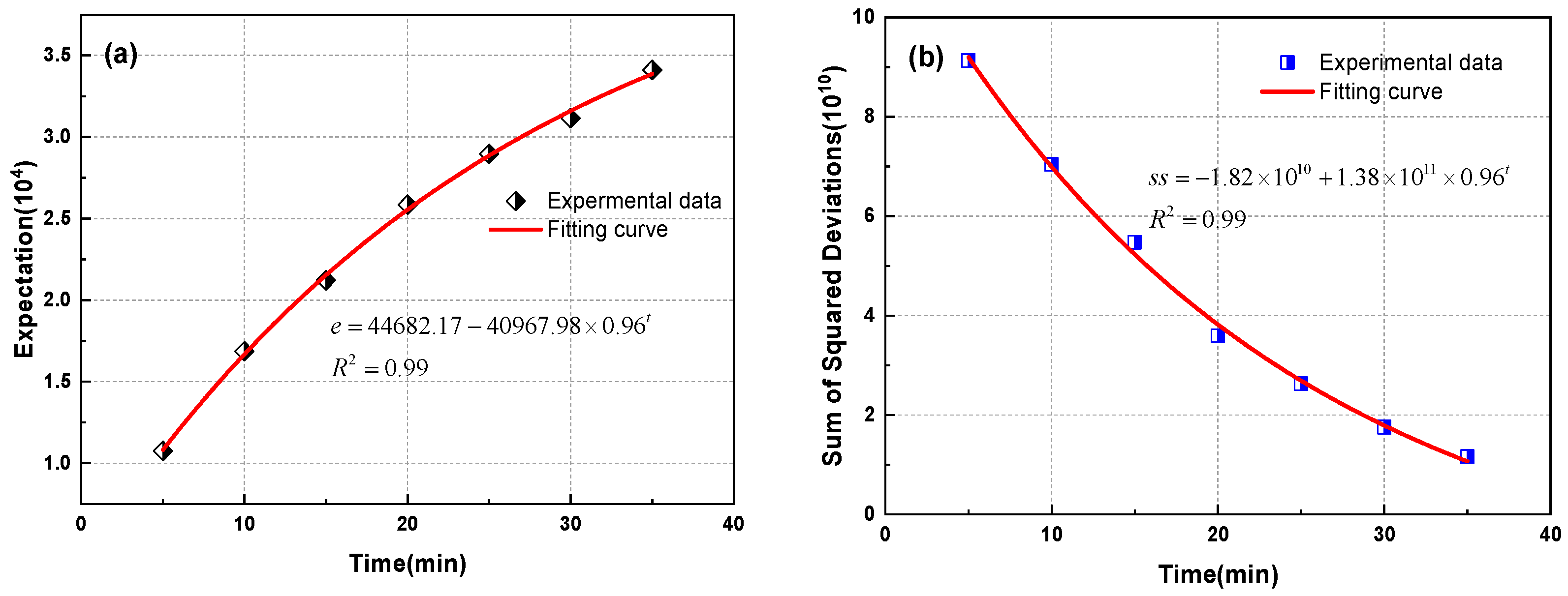
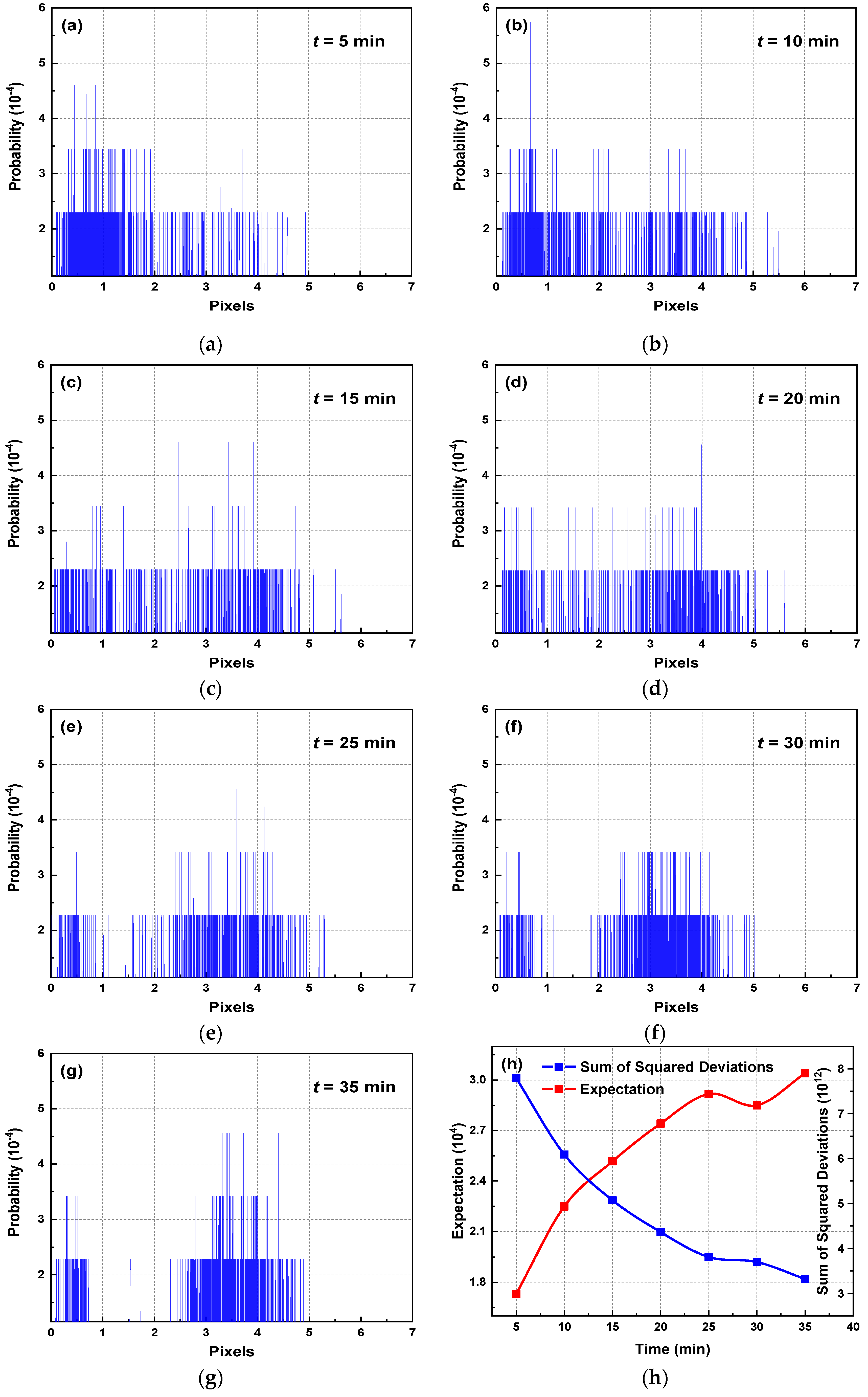
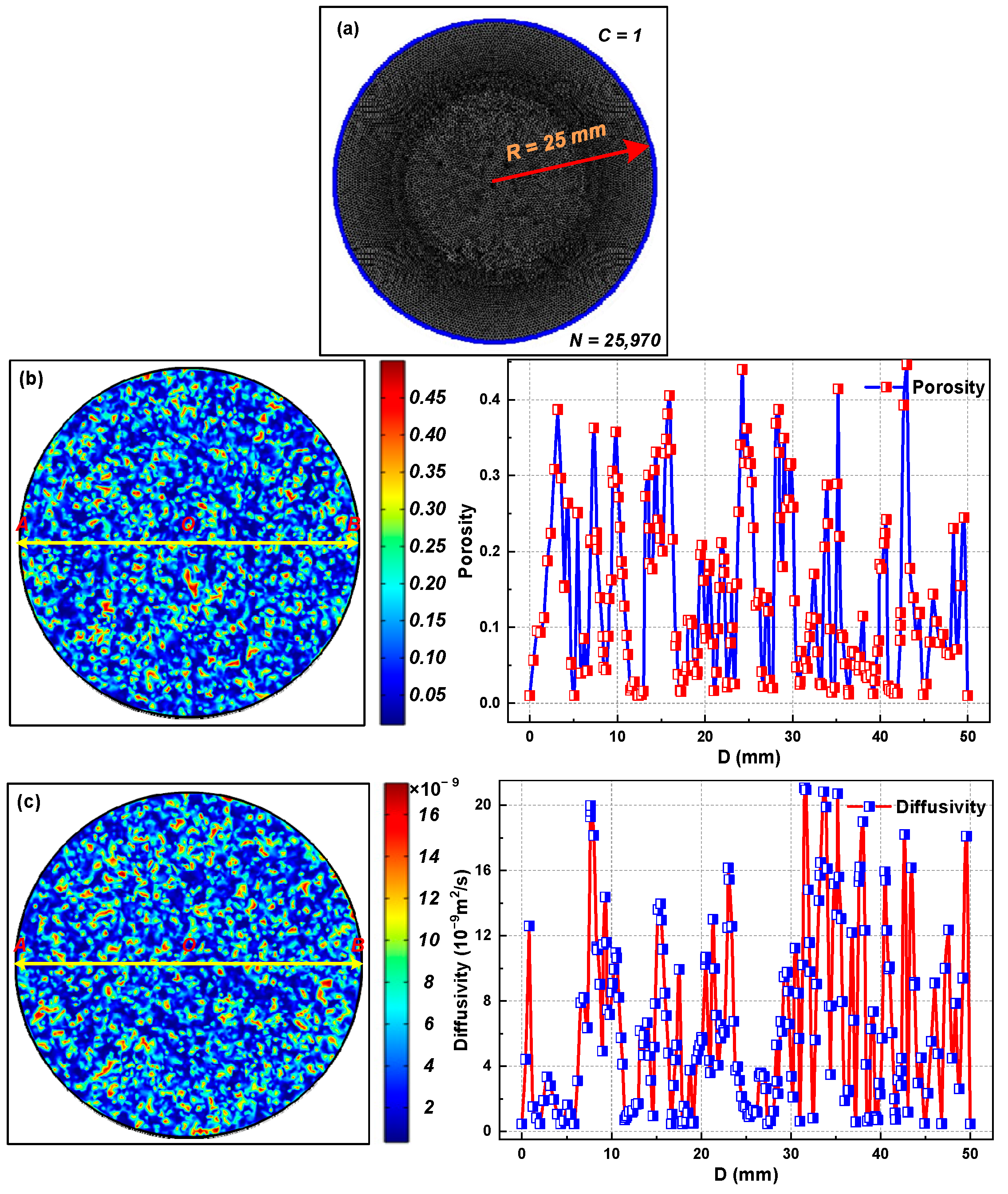
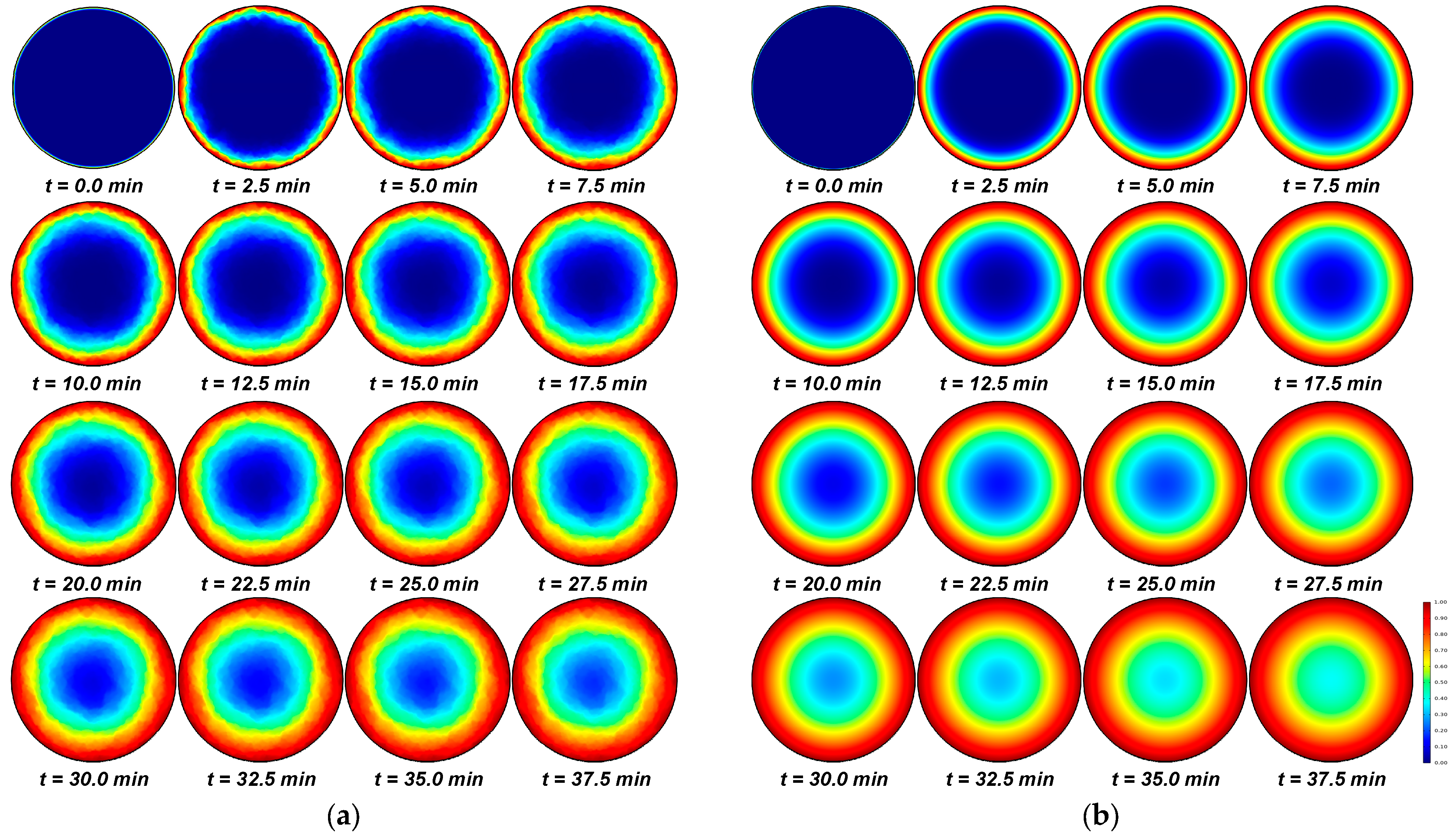



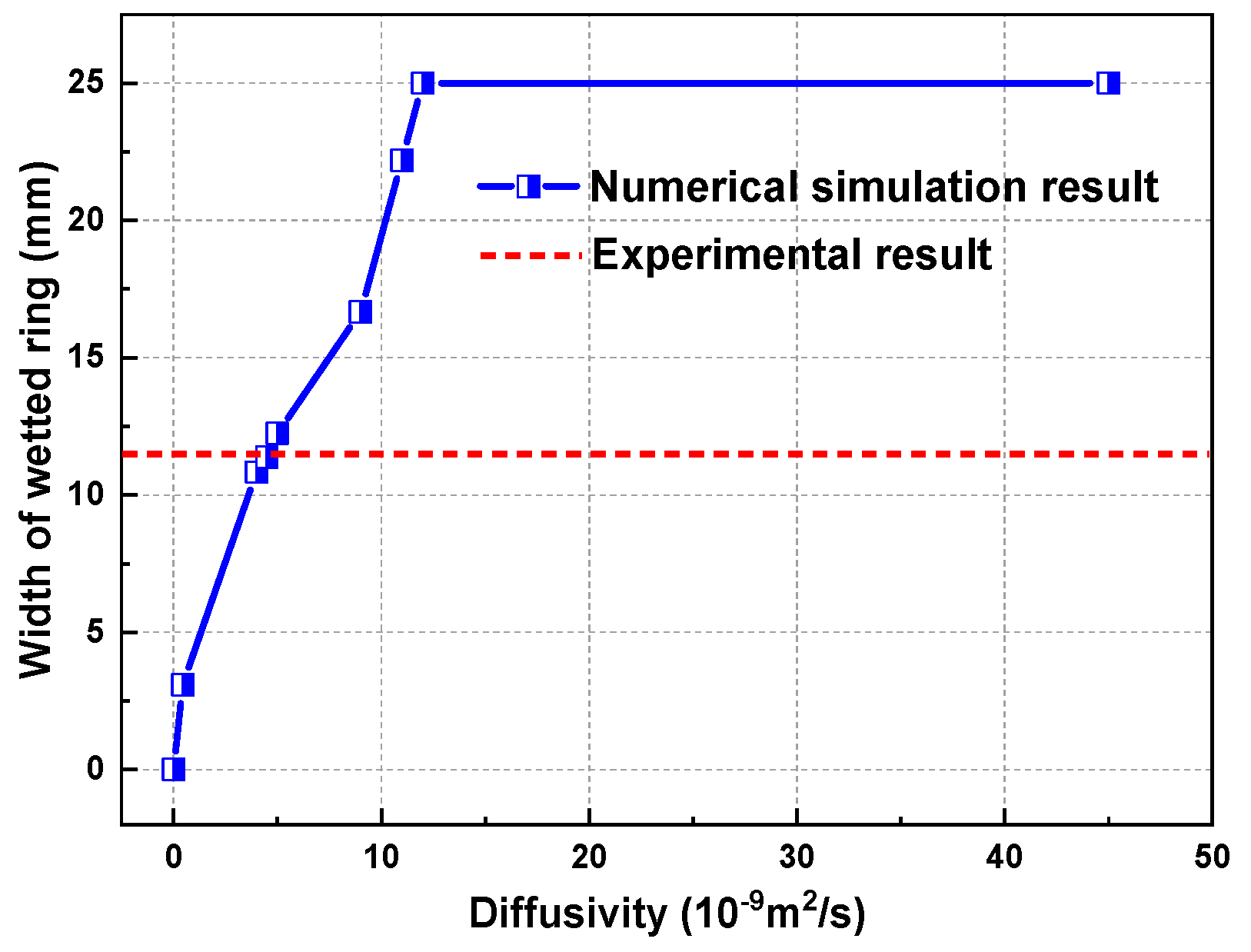
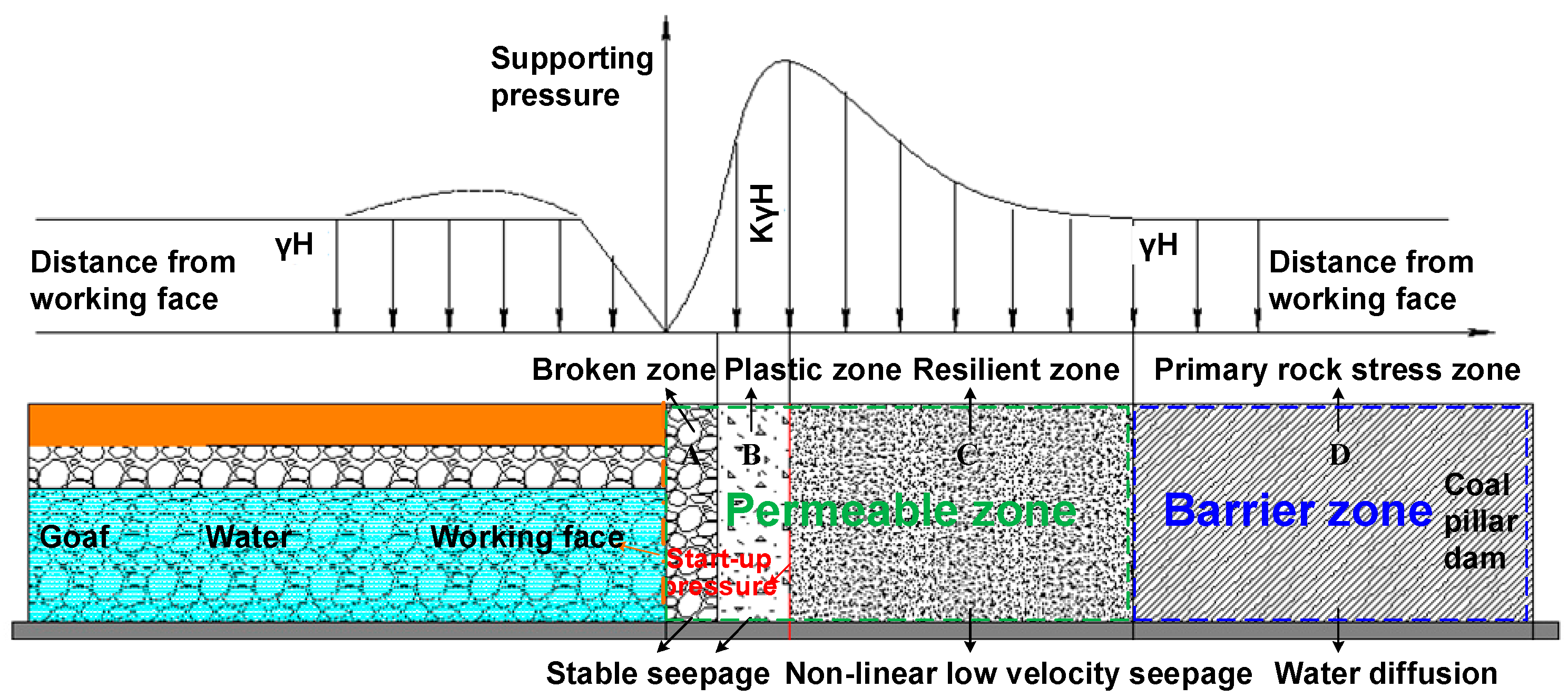

| Parameters | D0 (m2/s) | t (s) | φ0 | β | r/mm |
|---|---|---|---|---|---|
| value | 4.5 × 10−9 | 1.35 × 104 | 0.1 | 0.5 | 25 |
Disclaimer/Publisher’s Note: The statements, opinions and data contained in all publications are solely those of the individual author(s) and contributor(s) and not of MDPI and/or the editor(s). MDPI and/or the editor(s) disclaim responsibility for any injury to people or property resulting from any ideas, methods, instructions or products referred to in the content. |
© 2024 by the authors. Licensee MDPI, Basel, Switzerland. This article is an open access article distributed under the terms and conditions of the Creative Commons Attribution (CC BY) license (https://creativecommons.org/licenses/by/4.0/).
Share and Cite
Yu, L.; Li, X.; Chong, Z.; Xie, H. Spatial Distribution and Diffusion Characterisation of Water in Coal Samples: An Experimental Study. Processes 2024, 12, 671. https://doi.org/10.3390/pr12040671
Yu L, Li X, Chong Z, Xie H. Spatial Distribution and Diffusion Characterisation of Water in Coal Samples: An Experimental Study. Processes. 2024; 12(4):671. https://doi.org/10.3390/pr12040671
Chicago/Turabian StyleYu, Liqiang, Xuehua Li, Zhaohui Chong, and Hongxin Xie. 2024. "Spatial Distribution and Diffusion Characterisation of Water in Coal Samples: An Experimental Study" Processes 12, no. 4: 671. https://doi.org/10.3390/pr12040671




